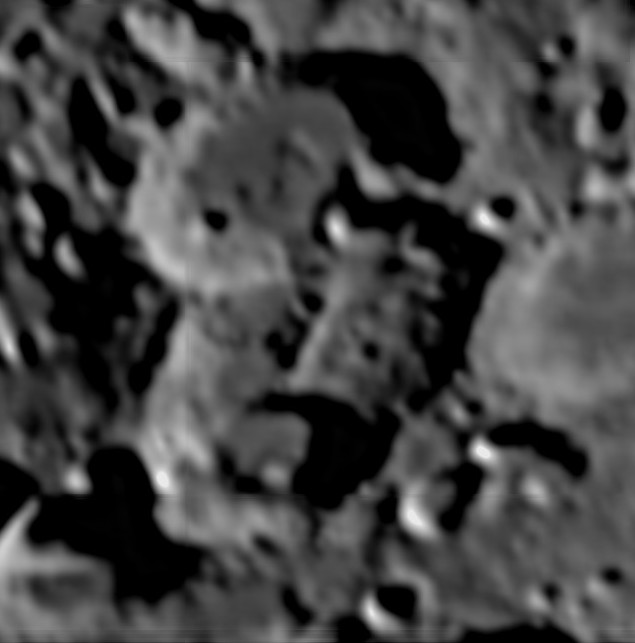Heraclitus (crater) on:
[Wikipedia]
[Google]
[Amazon]
 Heraclitus is a complex
Heraclitus is a complex  The circular southwest end is the most intact section, forming the circular satellite crater Heraclitus D, which is attached to the other two sections along the northeast rim. There are a pair of ghost-crater rims on the floor, and a low ridge in the southwest. The crater is 90 kilometers in diameter and 3.8 kilometers deep. It may be from the Pre-Imbrian period, which lasted from 4.55 to 3.85 billion years ago.
It is named after the 6th-century BC
The circular southwest end is the most intact section, forming the circular satellite crater Heraclitus D, which is attached to the other two sections along the northeast rim. There are a pair of ghost-crater rims on the floor, and a low ridge in the southwest. The crater is 90 kilometers in diameter and 3.8 kilometers deep. It may be from the Pre-Imbrian period, which lasted from 4.55 to 3.85 billion years ago.
It is named after the 6th-century BC
 Heraclitus is a complex
Heraclitus is a complex lunar
Lunar most commonly means "of or relating to the Moon".
Lunar may also refer to:
Arts and entertainment
* ''Lunar'' (series), a series of video games
* "Lunar" (song), by David Guetta
* "Lunar", a song by Priestess from the 2009 album ''Prior t ...
impact crater
An impact crater is a circular depression in the surface of a solid astronomical object formed by the hypervelocity impact of a smaller object. In contrast to volcanic craters, which result from explosion or internal collapse, impact craters ...
that lies in the rugged southern highlands of the Moon
The Moon is Earth's only natural satellite. It is the fifth largest satellite in the Solar System and the largest and most massive relative to its parent planet, with a diameter about one-quarter that of Earth (comparable to the width of ...
. The crater Licetus forms the northern end of the formation. Just to the east is Cuvier
Jean Léopold Nicolas Frédéric, Baron Cuvier (; 23 August 1769 – 13 May 1832), known as Georges Cuvier, was a French naturalist and zoologist, sometimes referred to as the "founding father of paleontology". Cuvier was a major figure in nat ...
, and due south is Lilius Lilius is a surname. Notable people with the surname include:
* Lilius family
* Aloysius Lilius (c. 1510–1576) principal author of the Gregorian Calendar
** Lilius (crater), named after him
* Franciszek Lilius (c. 1600–1657), Polish composer
* ...
. Just to the west of Heraclitus is the small satellite crater Heraclitus K, to the south of which is a pair of larger overlapping craters, Lilius E and Lilius D.''Autostar Suite Astronomer Edition''. CD-ROM. Meade, April 2006.
The entire formation is heavily worn, with features smoothed down by a long history of impacts. Heraclitus is a complex formation composed of three sections divided by a triple-armed interior ridge. Of the three sections, the most eroded and irregular is at the eastern end where the outer rim forms a low ridge that joins to Cuvier.
 The circular southwest end is the most intact section, forming the circular satellite crater Heraclitus D, which is attached to the other two sections along the northeast rim. There are a pair of ghost-crater rims on the floor, and a low ridge in the southwest. The crater is 90 kilometers in diameter and 3.8 kilometers deep. It may be from the Pre-Imbrian period, which lasted from 4.55 to 3.85 billion years ago.
It is named after the 6th-century BC
The circular southwest end is the most intact section, forming the circular satellite crater Heraclitus D, which is attached to the other two sections along the northeast rim. There are a pair of ghost-crater rims on the floor, and a low ridge in the southwest. The crater is 90 kilometers in diameter and 3.8 kilometers deep. It may be from the Pre-Imbrian period, which lasted from 4.55 to 3.85 billion years ago.
It is named after the 6th-century BC Greek
Greek may refer to:
Greece
Anything of, from, or related to Greece, a country in Southern Europe:
*Greeks, an ethnic group.
*Greek language, a branch of the Indo-European language family.
**Proto-Greek language, the assumed last common ancestor ...
philosopher Heraclitus
Heraclitus of Ephesus (; grc-gre, Ἡράκλειτος , "Glory of Hera"; ) was an ancient Greek pre-Socratic philosopher from the city of Ephesus, which was then part of the Persian Empire.
Little is known of Heraclitus's life. He wrote ...
.
Satellite craters
By convention these features are identified on lunar maps by placing the letter on the side of the crater midpoint that is closest to Heraclitus.References
{{Reflist Impact craters on the Moon